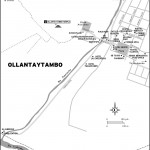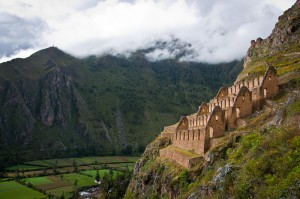
Take a day hike up to Inti Punku (Sun Gate). Photo © McKay Savage, licensed Creative Commons Attribution.
Ollantaytambo is a great base for a number of excellent hikes, treks, and community visits in the area. A detailed map of a dozen local hikes is available from the NGO Awamaki (Calle Convención s/n, across from the temple). Summaries of these hikes, taken from the Awamaki guide with permission, are listed here. Before setting out on these hikes, check with Awamaki for updated directions.This moderate, 1.5-hour hike explores the Inca ruins that can be seen from town on the hillside opposite the Ollantaytambo fortress. The larger buildings were used for agricultural storehouses called colcas. Along with the multiple Inca sites, this steep hike offers great elevated views of Ollantaytambo and the fortress.
To reach the trailhead from the plaza, take Calle Principal toward Cusco. Take your first left after leaving the plaza completely on Calle Lares. After a few blocks, you will see a stone staircase on your right with a sign for Pinkuylluna. The stone staircase continues up the mountain for 10 to 15 minutes before the trail forks. The trail to the right (with the wooden handrail) will lead you around the corner to the first Inca ruins.

Inca storehouses above Ollantaytambo. Photo by Kenneth Moore Photography licensed Creative Commons Attribution.
After exploring these, the best option is to descend back down to the fork in the trail and take the trail uphill in the other direction. The trail passes another Inca site and arrives at the large four-tiered storehouse in about 20-30 minutes. From here you can continue up the trail to the four towers that mark the crown of the head of the Tunupa, the god of abundance. If you continue up the mountain from here the views improve but the trail becomes unclear.The round-trip hike to the ruins of Pumamarca takes about 4-6 hours from Ollantaytambo on a moderate, steadily climbing trail. The ruins of Pumamarca sit on a hillside overlooking the convergence of the Río Patacancha and the Yuracmayo (White River). The well-preserved site was thought to be a checkpoint to control access to Ollantaytambo.
To reach Pumamarca, follow Patacalle out of town. Shortly after the first bridge, a large path leaves the main road to the right and follows the river. Follow this path for about 15 minutes until it rejoins the main road at the small town of Munaypata. Just up the road you will see an electrical pole on the left labeled 2224 and a path leading behind the adjacent house. Follow this path uphill for 15 more minutes to a blue archaeological marker for the Media Luna terraces in front of you. At this point, follow the switchback up the hill to your right (and not the path in front of you toward the terraces). The trail continues to climb steeply but soon becomes more gradual.
After another hour or so of hiking, the trail comes to a clearing with small waterfalls and the beginning of ancient aqueducts. The trail follows an aqueduct, and in 20-30 minutes the ruins of Pumamarca become apparent on the hillside in front of you. The trail becomes less clear at this point, but you can take multiple routes through the terraced fields up to the ruins (the main entrance is on the right side of the complex). At times there is someone working at the ruins who can provide information, but if not there is currently no entrance fee or hours when the ruins are closed. After exploring the ruins, return to Ollantaytambo by the same path or descend the hillside to the town of Pallata and take the road down from there.
This round-trip walk, which takes 4-6 hours to the quarries and a few more to reach the Sun Gate, begins at the Inca bridge near Ollantaytambo and along the banks of the Río Urubamba. It follows a fairly well-preserved Inca trail to Cachicata, the stone quarry 700-900 meters above the valley floor that is visible from the Ollantaytambo sun temple. It was here that the great stone blocks were slid down the hillside and hauled across the river to Ollantaytambo. There are three separate stone quarries, within half a kilometer of one another, littered with massive chiseled blocks and small chullpas, or burial towers. The western and highest quarry contains mysterious needleshaped blocks that are up to seven meters long.
From Cachicata, it is possible to see that the terraces below the Ollantaytambo ruins form a pyramid shape, with one 750-meter-long wall aligning with the rays of the winter solstice. New Age theorists Fernando and Edgar Elorieta believe this is the original Pakaritampu, where the four Inca brothers emerged to found Cusco. A few hours’ walk above the Cachicata is a perfect Inca gate that frames Salcantay in the background. On the trail approaching the quarries, numerous piedras cansadas (tired stones) that never made it to their final destination can be observed. The trail climbs high on the hillside, offering great views of Ollantaytambo and the surrounding peaks. Be prepared; the majority of the hike is fully exposed to the sun, and the only available water is near the beginning of the hike.
Begin the hike by taking a right after the Inca bridge. After about 15-20 minutes take a left at the fork up the hill (a boulder at the fork is labeled “Canteras”). Continue to stay left, following the main path when other trails diverge. In about 20-30 minutes you reach agricultural terraces and stone building foundations. Follow the trail straight past the foundations, not the smaller trail uphill. You arrive at the first quarry 1.5-2 hours after starting. Look for small stone buildings built on top of large boulders beneath you. Just after passing through the quarry, look for a smaller path to the left leading uphill from the large trail. If you choose to filter water, a small switchback to the left immediately after this turn will lead to the last water source.
Follow switchbacks up the hillside past the first quarry for one hour. As the grassy trail starts to level out, watch out for a rounded stone resembling a primitive wheel off the trail to your left. As the trail plateaus you will see a much larger quarry to your left and several small fields. These flat fields are a great place to camp if you plan to spend the night. A large boulder in the middle of the quarry has “Instituto Nacional de Cultura” painted in white. Before and to the left of this boulder, a path made of smaller stones leads up though the quarry. Exploring this path, you can find a burial site with skeletons under a large boulder, along with many quarried stones that never made it to Ollantaytambo.
Looking farther ahead on the same trail, you can see Inti Punku, or the Sun Gate, on the ridge ahead. To continue to Inti Punku, pass the large boulder with “I.N.C.” painted on it and head toward the largest boulder you see. Find the trail on the left side of the boulder and follow it uphill, crossing a scree field. After 30-45 minutes the trail comes to a grass field with Inca ruins (another good campsite). The trail continues just beyond and uphill from these. The trail forks once at a small ravine about 10 minutes from the Sun Gate; take a right through the ravine. About 30-45 minutes from the ruins you reach Inti Punku. From Inti Punku, return along same path to the last quarry (about 1 hour).
The return route from the canteras (quarries) should take 1.5-2 hours. Follow the trail down switchbacks to the first quarry. Take a left just past the first quarry on a small path and circle back under the quarry. From here you see two houses with metal roofs on the left hillside. Continue to descend along this ridge toward the houses and the trail improves. From the houses, continue along the trail downhill into the valley. The trail improves and continues downhill through more houses and finally to a bridge. Cross the bridge and follow the railroad tracks on your right. Turn left at a set of stone stairs after 10-15 minutes on tracks and follow the path back to town.
Excerpted from the Second Edition of Moon Machu Picchu.